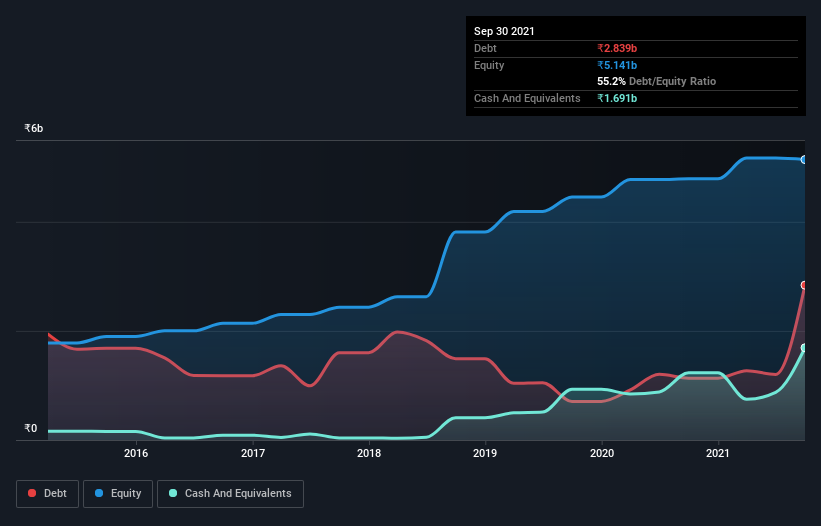Ganesha Ecosphere (NSE:GANECOS) Has A Pretty Healthy Balance Sheet

Some say volatility, rather than debt, is the best way to think about risk as an investor, but Warren Buffett famously said that 'Volatility is far from synonymous with risk.' When we think about how risky a company is, we always like to look at its use of debt, since debt overload can lead to ruin. As with many other companies Ganesha Ecosphere Limited (NSE:GANECOS) makes use of debt. But is this debt a concern to shareholders?
When Is Debt Dangerous?
Debt assists a business until the business has trouble paying it off, either with new capital or with free cash flow. Ultimately, if the company can't fulfill its legal obligations to repay debt, shareholders could walk away with nothing. However, a more frequent (but still costly) occurrence is where a company must issue shares at bargain-basement prices, permanently diluting shareholders, just to shore up its balance sheet. Of course, debt can be an important tool in businesses, particularly capital heavy businesses. When we think about a company's use of debt, we first look at cash and debt together.
View our latest analysis for Ganesha Ecosphere
What Is Ganesha Ecosphere's Net Debt?
As you can see below, at the end of September 2021, Ganesha Ecosphere had ₹2.84b of debt, up from ₹1.13b a year ago. Click the image for more detail. However, because it has a cash reserve of ₹1.69b, its net debt is less, at about ₹1.15b.

A Look At Ganesha Ecosphere's Liabilities
Zooming in on the latest balance sheet data, we can see that Ganesha Ecosphere had liabilities of ₹1.84b due within 12 months and liabilities of ₹2.15b due beyond that. Offsetting these obligations, it had cash of ₹1.69b as well as receivables valued at ₹1.02b due within 12 months. So its liabilities total ₹1.28b more than the combination of its cash and short-term receivables.
Of course, Ganesha Ecosphere has a market capitalization of ₹15.9b, so these liabilities are probably manageable. But there are sufficient liabilities that we would certainly recommend shareholders continue to monitor the balance sheet, going forward.
We use two main ratios to inform us about debt levels relative to earnings. The first is net debt divided by earnings before interest, tax, depreciation, and amortization (EBITDA), while the second is how many times its earnings before interest and tax (EBIT) covers its interest expense (or its interest cover, for short). This way, we consider both the absolute quantum of the debt, as well as the interest rates paid on it.
Ganesha Ecosphere's net debt is only 1.0 times its EBITDA. And its EBIT covers its interest expense a whopping 13.5 times over. So you could argue it is no more threatened by its debt than an elephant is by a mouse. Even more impressive was the fact that Ganesha Ecosphere grew its EBIT by 111% over twelve months. That boost will make it even easier to pay down debt going forward. There's no doubt that we learn most about debt from the balance sheet. But you can't view debt in total isolation; since Ganesha Ecosphere will need earnings to service that debt. So when considering debt, it's definitely worth looking at the earnings trend. Click here for an interactive snapshot.
But our final consideration is also important, because a company cannot pay debt with paper profits; it needs cold hard cash. So we always check how much of that EBIT is translated into free cash flow. In the last three years, Ganesha Ecosphere created free cash flow amounting to 9.4% of its EBIT, an uninspiring performance. For us, cash conversion that low sparks a little paranoia about is ability to extinguish debt.
Our View
The good news is that Ganesha Ecosphere's demonstrated ability to cover its interest expense with its EBIT delights us like a fluffy puppy does a toddler. But we must concede we find its conversion of EBIT to free cash flow has the opposite effect. Taking all this data into account, it seems to us that Ganesha Ecosphere takes a pretty sensible approach to debt. That means they are taking on a bit more risk, in the hope of boosting shareholder returns. The balance sheet is clearly the area to focus on when you are analysing debt. But ultimately, every company can contain risks that exist outside of the balance sheet. We've identified 2 warning signs with Ganesha Ecosphere (at least 1 which is concerning) , and understanding them should be part of your investment process.
Of course, if you're the type of investor who prefers buying stocks without the burden of debt, then don't hesitate to discover our exclusive list of net cash growth stocks, today.
New: Manage All Your Stock Portfolios in One Place
We've created the ultimate portfolio companion for stock investors, and it's free.
• Connect an unlimited number of Portfolios and see your total in one currency
• Be alerted to new Warning Signs or Risks via email or mobile
• Track the Fair Value of your stocks
Have feedback on this article? Concerned about the content? Get in touch with us directly. Alternatively, email editorial-team (at) simplywallst.com.
This article by Simply Wall St is general in nature. We provide commentary based on historical data and analyst forecasts only using an unbiased methodology and our articles are not intended to be financial advice. It does not constitute a recommendation to buy or sell any stock, and does not take account of your objectives, or your financial situation. We aim to bring you long-term focused analysis driven by fundamental data. Note that our analysis may not factor in the latest price-sensitive company announcements or qualitative material. Simply Wall St has no position in any stocks mentioned.
About NSEI:GANECOS
Ganesha Ecosphere
Primarily manufactures and sells recycled polyester staple fiber in India and internationally.
Solid track record with adequate balance sheet.
Market Insights
Community Narratives



